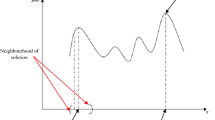Abstract
Semidefinite relaxation techniques have shown great promise for nonconvex optimal power flow problems. However, a number of independent numerical experiments have led to concerns about scalability and robustness of existing SDP solvers. To address these concerns, we investigate some numerical aspects of the problem and compare different state-of-the-art solvers. Our results demonstrate that semidefinite relaxations of large problem instances with on the order of 10,000 buses can be solved reliably and to reasonable accuracy within minutes. Furthermore, the semidefinite relaxation of a test case with 25,000 buses can be solved reliably within half an hour; the largest test case with 82,000 buses is solved within 8 h. We also compare the lower bound obtained via semidefinite relaxation to locally optimal solutions obtained with nonlinear optimization methods and calculate the optimality gap.


Similar content being viewed by others
References
Andersen MS (2018) OPFSDR v0.2.3. https://git.io/opfsdr. Accessed 4 Sept 2018
Andersen MS, Hansson A, Vandenberghe L (2014) Reduced-complexity semidefinite relaxations of optimal power flow problems. IEEE Trans Power Syst 29(4):1855–1863
Bai X, Wei H, Fujisawa K, Wang Y (2008) Semidefinite programming for optimal power flow problems. Int J Electr Power Energy Syst 30(6–7):383–392
Bingane C, Anjos MF, Digabel SL (2018) Tight-and-cheap conic relaxation for the AC optimal power flow problem. IEEE Trans Power Syst 33:7181–7188
Birchfield AB, Xu T, Gegner KM, Shetye KS, Overbye TJ (2017) Grid structural characteristics as validation criteria for synthetic networks. IEEE Trans Power Syst 32(4):3258–3265
Boyd S, Vandenberghe L (2004) Convex optimization. Cambridge University Press, Cambridge
Byrd RH, Nocedal J, Waltz RA (2006) Knitro: an integrated package for nonlinear optimization. In: Pillo G, Roma M (eds) Large scale nonlinear optimization. Springer, Berlin, pp 35–59
Carpentier J (1962) Contribution á l’étude du dispatching économique. Bull de la Soc Fr Électr 3:431–447
Coffrin C, Hijazi H, Van Hentenryck P (2016) The QC relaxation: a theoretical and computational study on optimal power flow. IEEE Trans Power Syst 31(4):3008–3018
Fukuda M, Kojima M, Murota K, Nakata K (2001) Exploiting sparsity in semidefinite programming via matrix completion I: general framework. SIAM J Optim 11(3):647–674
Grant M, Boyd S (2008) Graph implementations for nonsmooth convex programs. In: Blondel V, Boyd S, Kimura H (eds) Recent advances in learning and control. Lecture notes in control and information sciences. Springer, Berlin, pp 95–110
Hijazi H, Coffrin C, Van Hentenryck P (2016) Polynomial SDP cuts for optimal power flow. In 19th Power Systems Computation Conference, PSCC 2016
Hijazi H, Coffrin C, Hentenryck PV (2017) Convex quadratic relaxations for mixed-integer nonlinear programs in power systems. Math Program Comput 9(3):321–367
Jabr RA (2006) Radial distribution load flow using conic programming. IEEE Trans Power Syst 21(3):1458–1459
Jabr RA (2012) Exploiting sparsity in SDP relaxations of the OPF problem. IEEE Trans Power Syst. 27(2):1138–1139
Josz C, Maeght J, Panciatici P, Gilbert JC (2015) Application of the moment-SOS approach to global optimization of the OPF problem. IEEE Trans Power Syst 30(1):463–470
Josz C, Fliscounakis S, Maeght J, Panciatici R (2016) AC power flow data in MATPOWER and QCQP format: iTesla, RTE snapshots, and PEGASE. arXiv:1603.01533v3
Kocuk B, Dey SS, Sun XA (2016) Strong socp relaxations for the optimal power flow problem. Oper Res 64(6):1177–1196
Kourounis D, Fuchs A, Schenk O (2018) Toward the next generation of multiperiod optimal power flow solvers. IEEE Trans Power Syst 33(4):4005–4014
Lavaei J, Low SH (2012) Zero duality gap in optimal power flow problem. IEEE Trans Power Syst 27(1):92–107
Löfberg J (2004) YALMIP: a toolbox for modeling and optimization in MATLAB. In Proceedings of the CACSD Conference, Taipei, Taiwan
Low SH (2014a) Convex relaxation of optimal power flow—part I: formulations and equivalence. IEEE Trans Control Netw Syst 1(1):15–27
Low SH (2014b) Convex relaxation of optimal power flow—part II: exactness. IEEE Trans Control Netw Syst 1(2):177–189
Madani R, Kalbat A, Lavaei J (2017) A Low-Complexity Parallelizable Numerical Algorithm for Sparse Semidefinite Programming. In: IEEE Transactions on Control of Network Systems, vol 5, no 4. pp 1898–1909. https://doi.org/10.1109/TCNS.2017.2774008
Mak TWK, Shi L, Hentenryck PV (2018) Phase transitions for optimality gaps in optimal power flows a study on the French transmission network. arXiv:1807.05460
Mittelmann HD (2003) An independent benchmarking of SDP and SOCP solvers. Math Program 95(2):407–430
Molzahn DK, Hiskens IA (2015) Sparsity-exploiting moment-based relaxations of the optimal power flow problem. IEEE Trans Power Syst 30(6):3168–3180
Molzahn DK, Holzer JT, Lesieutre BC, DeMarco CL (2013) Implementation of a large-scale optimal power flow solver based on semidefinite programming. IEEE Trans Power Syst 28(4):3987–3998
MOSEK (2015) MOSEK optimizer API for Python. https://docs.mosek.com/8.1/pythonapi/index.html
O’Donoghue B, Chu E, Parikh N, Boyd S (2016) Conic optimization via operator splitting and homogeneous self-dual embedding. J Optim Theory Appl 169(3):1042–1068
PGLib-OPF (2018) Power Grid Lib—Optimal Power Flow v18.08. https://git.io/pglib-opf. Accessed 4 Sept 2018
Sturm JF (1999) Using SeDuMi 1.02, a MATLAB toolbox for optimization over symmetric cones. Optim Methods Softw 11(1):625–653
Taylor JA (2015) Convex optimization of power systems. Cambridge University Press, Cambridge
Toh KC, Todd MJ, Tütüncü RH (1999) SDPT3—a Matlab software package for semidefinite programming, version 1.3. Optim Methods Softw 11(1–4):545–581
Wächter A, Biegler LT (2006) On the implementation of an interior-point filter line-search algorithm for large-scale nonlinear programming. Math Program 106(1):25–57
Wang H, Murillo-Sanchez CE, Zimmerman RD, Thomas RJ (2007) On computational issues of market-based optimal power flow. IEEE Trans Power Syst 22(3):1185–1193
Zheng Y, Fantuzzi G, Papachristodoulou A, Goulart P, Wynn A (2016) CDCS: cone decomposition conic solver, version 1.1. https://github.com/giofantuzzi/CDCS
Zimmerman RD, Murillo-Sánchez CE, Thomas RJ (2011) MATPOWER: steady-state operations, planning, and analysis tools for power systems research and education. IEEE Trans Power Syst 26(1):12–19
Author information
Authors and Affiliations
Corresponding author
Additional information
Publisher's Note
Springer Nature remains neutral with regard to jurisdictional claims in published maps and institutional affiliations.
Rights and permissions
About this article
Cite this article
Eltved, A., Dahl, J. & Andersen, M.S. On the robustness and scalability of semidefinite relaxation for optimal power flow problems. Optim Eng 21, 375–392 (2020). https://doi.org/10.1007/s11081-019-09427-4
Received:
Revised:
Accepted:
Published:
Issue Date:
DOI: https://doi.org/10.1007/s11081-019-09427-4




